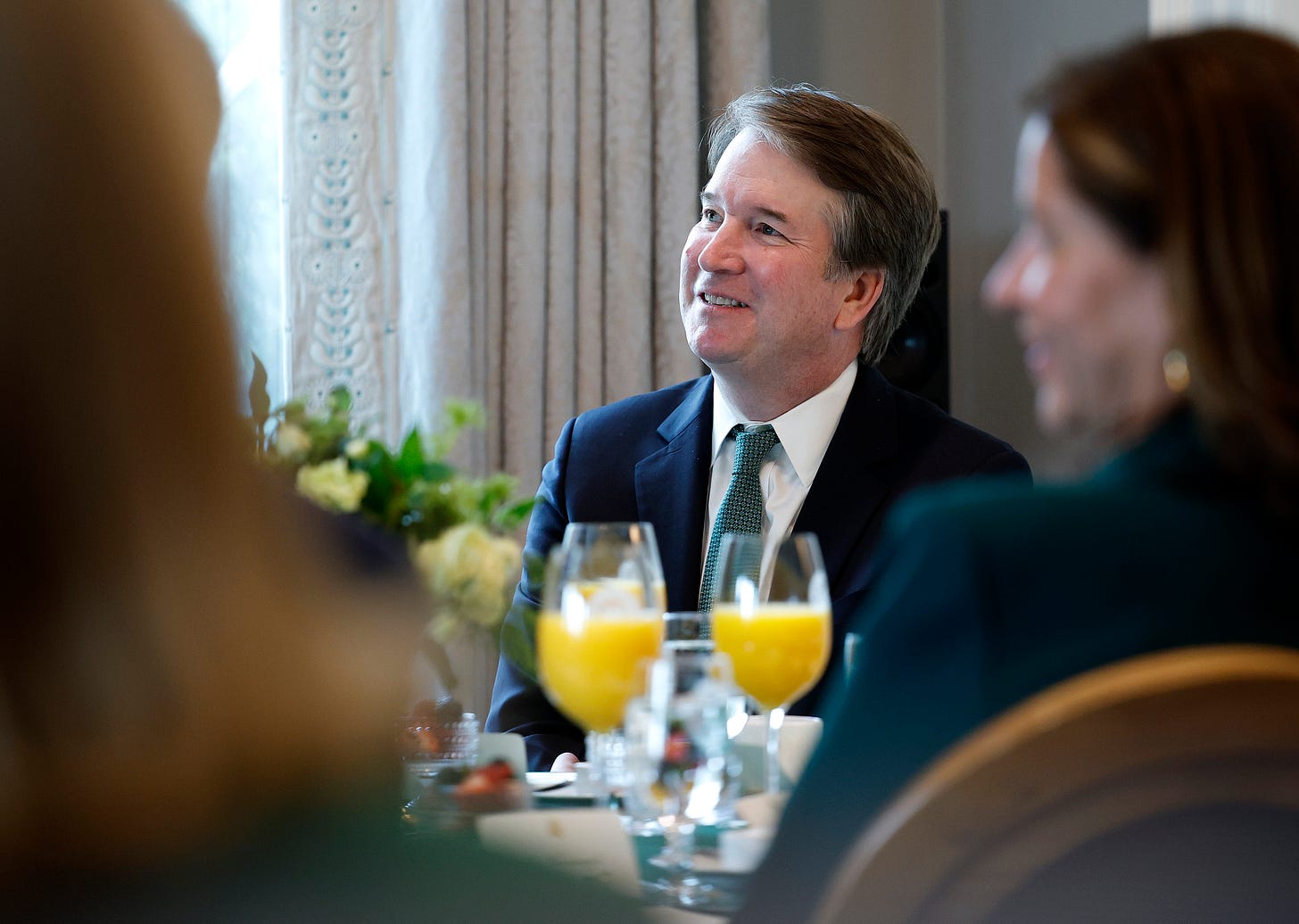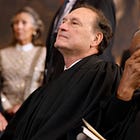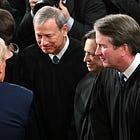Brett Kavanaugh explains that SCOTUS really IS doing racism
He showed his whole hood.
PN is supported by paid subscribers. Become one 👇
On Monday, the Supreme Court’s six conservatives legalized racial profiling, allowing ICE to snatch any non-white person off the street and lock them up until they “prove” their citizenship.
And they did it on the shadow docket, simply mumbling that the lower court’s order was “stayed pending the disposition of the appeal in the United States Court of Appeals for the Ninth Circuit and disposition of a petition for a writ of certiorari, if such a writ is timely sought.”
This was clearly a calculation by five justices that it was better to remain silent and be thought of as a bunch of racist hacks with no regard for law or precedent than to speak out and remove all doubt. But Justice Kavanaugh, channeling his inner Col. Jessup, refused to sign on to the plan.
Kavanaugh penned a concurrence confirming that, yes, the conservative justices are motivated by gutter racism. And they absolutely do intend to shred five decades of Fourth Amendment jurisprudence to make it happen.
YOU’RE GODDAMN RIGHT THEY ORDERED THE CONSTITUTIONAL CODE RED, SON! And they’ll do it again.
Perdomo v. Noem
In June, the Trump administration unleashed wave after wave of immigration sweeps in Los Angeles. The footage of heavily-armed, masked men in tactical gear indiscriminately detaining every brown person they could get their hands on shocked the country.
Multiple men who were detained, along with several immigrant rights groups, sued in federal court seeking to block the dragnets, and on July 11, Judge Maame Frimpong issued a 52-page order enjoining the government from using race as a basis for stopping individuals and demanding proof of citizenship. Specifically, she barred “detentive stops in this District unless the agent or officer has reasonable suspicion that the person to be stopped is within the United States in violation of US immigration law.”
In the immigration context, the Supreme Court has defined reasonable suspicion as a “particularized and objective basis for suspecting the particular person stopped of criminal activity.” In 1975, it held in a case called US v. Brignoni-Ponce that driving while Mexican near the Mexican border did not constitute reasonable suspicion to detain someone and inquire about their citizenship.
Citing Brignoni-Ponce, Judge Frimpong barred the government from relying solely on four factors, “alone or in combination,” as the basis for the “reasonable suspicion” required for a detentive stop:
i. Apparent race or ethnicity;
ii. Speaking Spanish or speaking English with an accent;
iii. Presence at a particular location (e.g. bus stop, car wash, tow yard, day laborer pick up site, agricultural site, etc.); or
iv. The type of work one does.
The DOJ appealed, and the Ninth Circuit upheld the trial judge’s ruling, finding that the searches clearly violated the Fourth Amendment’s prohibition on unreasonable seizures by the government.
“[T]he factors at issue here impermissibly ‘cast suspicion on large segments of the law-abiding population,’ including anyone in the District who appears Hispanic, speaks Spanish or English with an accent, wears work clothes, and stands near a carwash, in front of a Home Depot, or at a bus stop,” the three-judge appellate panel agreed.
They added:
This conclusion is amply supported by the record, which shows that US citizens and lawfully present immigrants were seized based on the four factors or a subset of them — including the three US Citizens discussed above, an 11-year-old US citizen at a carwash, a lawfully present day laborer outside a Home Depot, and a legally present immigrant who was stopped by Defendants once while driving and again while standing outside a Home Depot.
And so the government raced to DC, demanding that Trump’s six pals at One First Street bail him out. Which they did.
The shady, shady shadow docket
It’s impossible to separate what happened in this case from the larger debate about the shadow docket, where the Court issues rulings without the benefit of full briefing and argument on the merits.
Lawyers have long condemned these ostensibly emergency orders, which are often unsigned and just a paragraph long. But the public only became aware of the issue in 2021 when the Court basically overturned Roe v. Wade on the shadow docket, staying a lower court’s order and effectively allowing Texas to ban abortion.
Justice Samuel Alito, who later penned the Dobbs decision officially overturning Roe, has been exceptionally thin-skinned about criticism of the Court’s shadow docket rulings.
“Recently, the catchy and sinister term ‘shadow docket’ has been used to portray the court as having been captured by a dangerous cabal that resorts to sneaky and improper methods to get its ways,” he seethed in 2021. “This portrayal feeds unprecedented efforts to intimidate the court or damage it as an independent institution.”
But since Trump’s return to the White House, the conservative justices have routinely used the shadow docket to take a Sharpie to lower court rulings requiring the Trump administration to comply with the law. Public criticism of the shadow docket is at a fever pitch. Frustrated trial judges complain anonymously to NBC’s Lawrence Hurley that they feel “thrown under the bus,” and US District Judge Allison Burroughs even included an angry footnote in the Harvard funding case warning that “the Supreme Court’s recent emergency docket rulings regarding grant terminations have not been models of clarity, and have left many issues unresolved.”
All of which is to say that the Supreme Court’s conservatives are keenly aware that every shadow docket order chips further away at their own legitimacy. And still five justices were willing to pay the price when it came to the racial profiling order. Rather than explain their reasoning, or rebut the bitterly angry dissent by Justice Sotomayor for the Court’s three liberals, they offered a single paragraph of legalese, devoid of any reasoning or explanation.
But Justice Kavanaugh refused to go along with the plan. Instead, he explained his own thinking in a concurring statement. And that thinking was shockingly racist.
Justice Leeroy Jenkins
Kavanaugh began by accepting the government’s claim that one in 10 residents of LA is an undocumented immigrant. There is no citation for this figure, and there’s some evidence that it’s wildly inaccurate. But it undergirds Kavanaugh’s entire legal theory, so he wasn’t about to factcheck it!
“Not surprisingly given those extraordinary numbers, US immigration officers have prioritized immigration enforcement in the Los Angeles area,” he went on, noting “the myriad ‘significant economic and social problems’ caused by illegal immigration.”
That internal quote about immigrants causing “significant economic and social problems” is actually dicta from Brignoni-Ponce, a decision which is five decades old. Recent data proves that immigrants greatly strengthen the US economy and commit crimes at significantly lower rates than native-born Americans — which is why only blood and soil nationalists say that stuff today.
And while Kavanaugh was happy to cherrypick quotes from Brignoni-Ponce, he wildly mischaracterized its holding. There, the Court ruled that race plus location could not add up to reasonable suspicion because it would necessarily sweep up lots of people who were entirely innocent — the exact opposite of Kavanaugh’s conclusion, even with his demographic fudge to make it seem like every brown person ICE encounters in LA is likely to be an undocumented immigrant.
Kavanaugh went on to grossly mischaracterize the nature of the roving immigration patrols. Here’s his cheerful description of the interactions:
Importantly, reasonable suspicion means only that immigration officers may briefly stop the individual and inquire about immigration status. If the person is a US citizen or otherwise lawfully in the United States, that individual will be free to go after the brief encounter. Only if the person is illegally in the United States may the stop lead to further immigration proceedings.
Here’s how Judge Frimpong, who actually heard testimony from the plaintiffs, characterized it:
Agents and officers approach suddenly and in large numbers in military style or SWAT clothing, heavily armed with weapons displayed, masked, and with their vest displaying a generic "POLICE" patch (if any display at all). Agents typically position themselves around individuals, aggressively engage them, and/or shout commands, making it nearly impossible for individuals to decline to answer their questions. When individuals have tried to avoid an encounter with agents and officers, they have been followed and pushed to the ground, sometimes even beaten, and then taken away.
And here’s how that “brief encounter” went down for one US citizen, as summarized by Justice Sotomayor:
On June 9, immigration agents arrived at a tow yard in Montebello “carrying handguns” and “military-style rifle[s].” Jason Gavidia, a Latino US citizen, was working on his car in the tow yard that day. A masked agent ordered Gavidia to “‘[s]top right there’” and began asking him questions. Agents then asked Gavidia whether he is “American at least three times”; three times, Gavidia affirmed that he is. Unsatisfied, the agents asked Gavidia for the name of the hospital in which he was born, and when Gavidia could not immediately recall, the agents racked a rifle, took Gavidia’s phone, “pushed [him] up against the metal gated fence, put [his] hands behind [his] back, and twisted [his] arm.” Agents released Gavidia only after he offered up his REAL ID. That ID was never returned to him.
Kavanaugh closed by pretending that undocumented immigrants are not entitled to the protections of the Constitution.
“[B]y illegally immigrating into and remaining in the country, they are not only violating the immigration laws, but also jumping in front of those noncitizens who follow the rules and wait in line to immigrate into the United States through the legal immigration process,” he tut-tuts. “For those reasons, the interests of illegal immigrants in evading questioning (and thus evading detection of their illegal presence) are not particularly substantial as a legal matter.”
That is simply not the law.
The Fourth Amendment protects “the right of the people to be secure in their persons, houses, papers, and effects, against unreasonable searches and seizures.” Nowhere does it refer to “citizens,” and the Supreme Court has long held that non-citizens are entitled to due process and other protections of the the Constitution.
Trying to hive off non-citizens from “the people” really gives the whole racist game away.
Hiding their shame
It’s not clear why Justice Kavanaugh indulged himself in this embarrassing display. Perhaps he’s so chagrined by critiques of the shadow docket that he simply couldn’t help himself. He has been assiduously trying to rebrand it as the “interim docket,” presumably to make it sound less, well, shady.
But there was a way to do this without disgracing himself and the Court. Indeed, Kavanaugh took a brief breath in the midst of explaining why Latinos are outside the protection of the law to opine that this case should probably be dismissed on standing grounds alone. That is, by finding that the plaintiffs here aren’t entitled to sue, the conservatives might be able to give Trump what he wants without explicitly endorsing racial profiling.
Kavanaugh could have explained his position without showing his whole hood, and his colleagues may ultimately seize that fig leaf when they hear the case in regular order. But thanks to Kavanaugh’s big mouth, no one will buy that ruse.
As Maya Angelou said, “When people show you who they are, believe them.”
That’s it for today
We’ll be back with more tomorrow. If you appreciate this edition, please do your part to keep Public Notice free by signing up for a paid subscription.
Thanks for reading.







After Biden v. Nebraska, any reliance on the standing doctrine is purely political.
For those not familiar, Biden v Nebraska is the student loan case in which John Roberts and the Fash Five struck down the effort to help struggling student loan debtors. Several states sued, The lower courts dismissed for lack of standing. That was right, because no state had any actual injury.
The six frauds held that Missouri had standing because it had chartered a student loan processing corporation which had refused to participate in the iltigation. The frauds that Missouri was damaged because if loans were cancelled the student loan company wouldn't collect as much money, and that might mean that Missouri would not get a bit of money if the student loan company ever paid anything. In other words, no actual tangible injury.
That's ridiculous. I actually own stock in corporations that actually pay dividends, but that doesn't give me standing to sue if the government cuts funding to one of them, and Missouri didn't even own stock. The explanation for why the plan was unconstitutional is ever more stupid.
Brilliant and insightful as always. I love reading your pieces in PN!